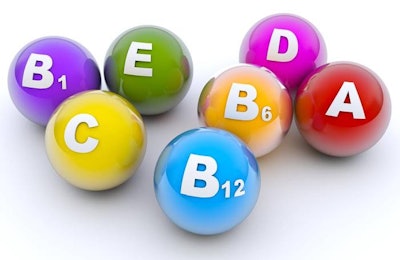
Vitamins are organic compounds sensitive to a myriad of physical and chemical reactions that affect their potency. For example, vitamin A has five double bonds highly susceptible to oxidation, whereas vitamin E is a natural antioxidant rapidly consumed without its own protection. During feed manufacturing and storage, oxidative conditions often arise that may reduce vitamin stability. Unless vitamin destruction is prevented or compensated, animal performance may be reduced depending on severity and duration of imposed vitamin deficiency.
Selecting vitamins to use in a premix
The chemical form of vitamins affects stability and resistance to oxidation. For example, pure vitamin A (retinol) is more susceptible than its ester form (retinyl acetate), which in turn is more susceptible to oxidation than coated vitamin A (insoluble in water). Likewise, esterification of vitamin E (tocopheryl acetate) is more stable than pure vitamin E (tocopherol). In general, the greater the water solubility of a vitamin the greater the risk for oxidation. Thus, thiamin mononitrate (10 percent solubility) is more stable than thiamine monochloride (100 percent solubility). Thus, vitamin potency is only half the story when designing a premix; the other half is vitamin form, which affects its shelf-life during storage.
Physical form also affects stability. There are vitamins that are stable in crystalline form (thiamin, pyridoxine), but most vitamins benefit from some form of protection. For example, spray-dried beadlets of vitamin A and D, fat-coated vitamin C, vitamin E and choline chloride adsorbed in silica carrier all possess far greater stability than their unprotected forms. Yet, some forms of vitamin protection may not be practical for feed manufacturing. Such examples include ethylcellulose coating and vitamin-starch spray-dried emulsions that decrease flowability due to increased adhesiveness.
Processing and storage
Vitamins are exposed to oxidative conditions also during thermal processing of feed. Thus, processes such as pelleting, extrusion and expansion may have a detrimental impact on vitamin retention in finished feed. During thermal processing, vitamins are exposed to high levels of temperature, humidity, pressure and friction that dramatically increase the rate of oxidation. For example, pure vitamin C (ascorbic acid) retention after pelleting at about 68C was only 65 percent and it was further reduced to only 25 percent when pelleting temperature reached 108C. In contrast, ascorbyl phosphate (a more stable form of vitamin C) retention was almost 90 percent, even at 108C. Extrusion at 93C versus 143C decreased retention of thiamin hydrochloride from 90 to 50 percent, but when thiamine mononitrate was used, retention was 94 and 77 percent. It is evident, therefore, that more stable vitamin forms must be used under aggressive thermal processing conditions.
In general, the greater the water solubility of a vitamin, the greater the risk for oxidation.
Prolonged storage is another issue that affects vitamin stability. In containers with straight vitamins, stability is extremely high, especially when container design prevents exposure to oxygen and moisture. Most vitamins are expected to exhibit less than 0.1 percent monthly potency reduction in unopened containers for at least 12 months, whereas monthly loses in open containers approach 0.5 percent for most vitamins, with notable exceptions. For example, monthly reduction of menadione sodium bisulfate (vitamin K) potency was 2 percent and 0 percent in open and unopened containers over a period of six months. Natural vitamin E (retinol) losses are also high (5 percent and 8 percent monthly in unopened and open containers) but become negligible in retinol acetate (less than 0.1 percent).
Vitamin and trace mineral premixes
In vitamin premixes and complete diets, vitamin stability is markedly affected by contact with certain trace minerals and choline chloride that cause friction and accelerate oxidation. Copper, zinc and iron are very reactive, whereas selenium, iodine and manganese are almost inert. Free metal ions are most reactive, followed by sulfate, carbonate and oxide salts, with chelated minerals being virtually inert. Thus, blends of vitamins and trace minerals are expected to exhibit reduced vitamin retention, especially during prolonged storage and (or) elevated temperature/humidity conditions. For example, riboflavin in a straight vitamin premix retained 93 percent of its potency after six months of storage. But, when the premix also included trace minerals, retention dropped to 71 percent. Choline chloride also reduced riboflavin retention from 99 to 95 percent after six months.
Not all vitamins, however, are affected by trace minerals and choline chloride. For example, retention of folic acid after six months was 80 percent regardless of blending with trace minerals, and retention of retinol acetate remained constant with or without chlorine chloride. In diets and premixes for young pigs that contain pharmacological concentrations of zinc oxide and copper sulfate, vitamin retention becomes problematic, and these salts should be kept separately from vitamins.
Prevention and compensation
Prevention and (or) compensation are the main options to offset the negative effects of reduced vitamin stability during feed manufacturing. Vitamin stability is enhanced when:
- Vitamin storage is minimum and under appropriate conditions
- Vitamins are not premixed with reactive ingredients
- Vitamins bypass thermal processing (added as liquid after processing) or processed under less aggressive conditions
However, based on the relative low requirements for formulation space (most vitamin premixes are included at less than 1 percent of the final formula) and relatively low cost (1-2 percent of total diet cost), over-formulation is the most common method of compensating against potential vitamin losses. Margins of safety may range from 20 to 100 percent for the more expensive or toxic vitamins (e.g., vitamins A, D and E), but may easily exceed 1,000 percent for certain B vitamins. Guides to calculate vitamin fortification levels based on expected losses are furnished by most major vitamin suppliers, but these are usually overgenerous. More appropriate (intermediate) levels should be sought after thorough consultation with experts to design custom-made premixes.
Find out how to stop wasting vitamins, trace minerals in animal feeds

















